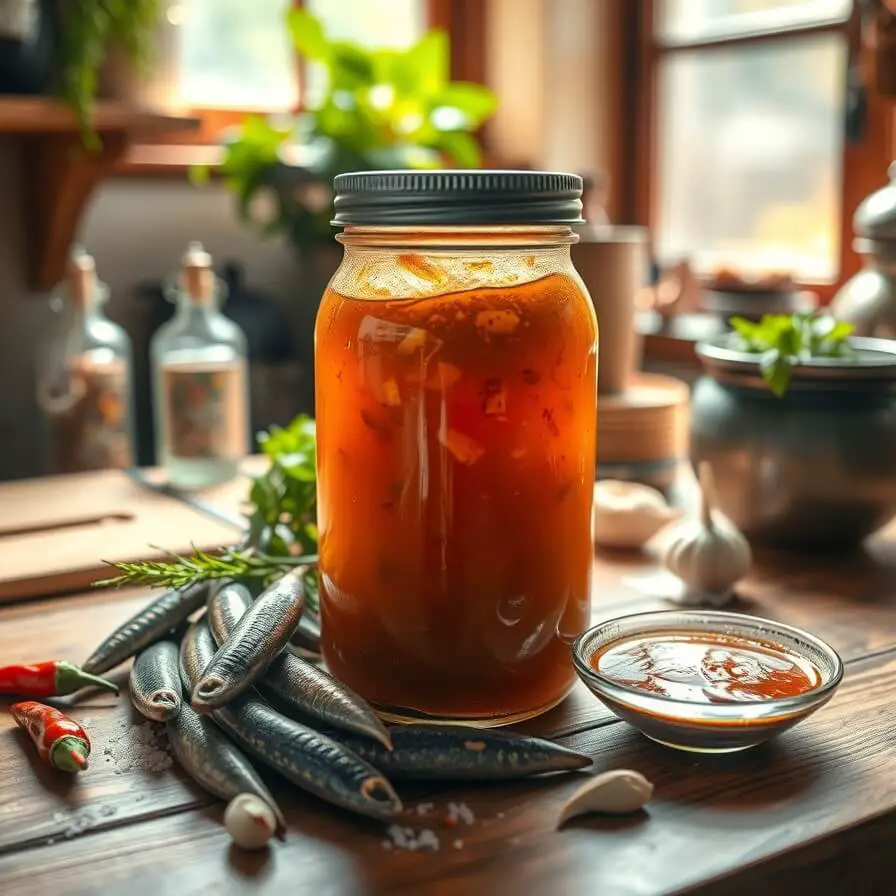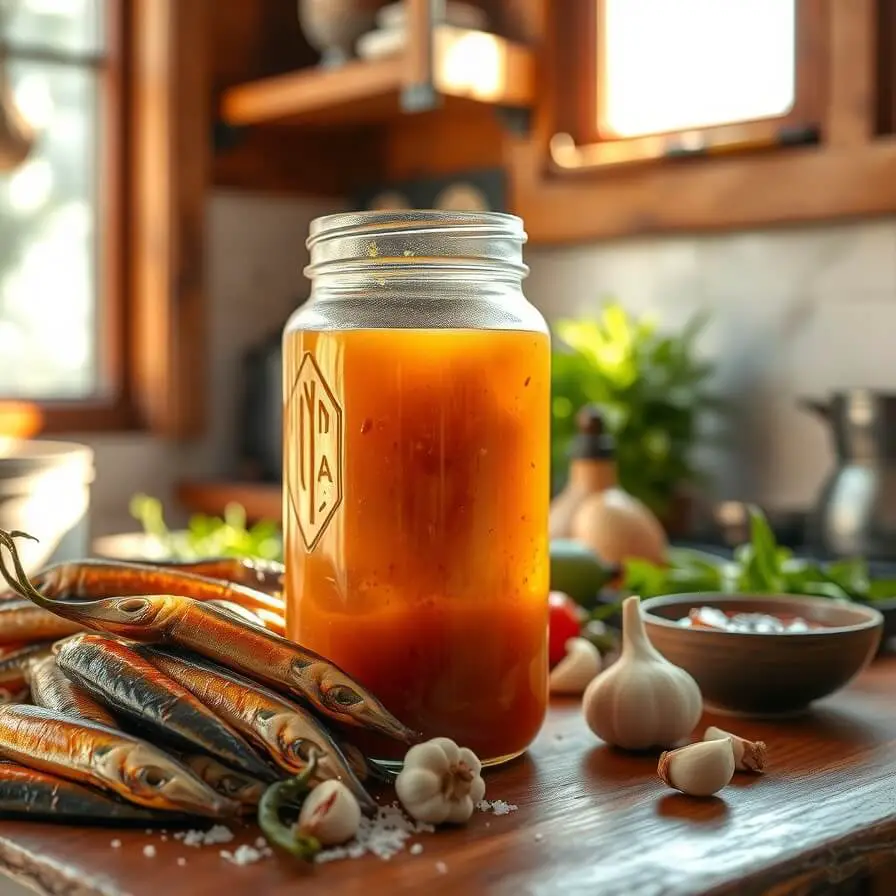Homemade Fish Sauce Recipe

I still remember the first time I tried making fish sauce at home. I was nervous—after all, this is one of those ingredients that people either adore or shy away from entirely. But there was something about the idea of creating this deeply flavorful, umami-rich staple from scratch that fascinated me. My grandmother always used it in her cooking, letting a few drops transform an ordinary dish into something memorable. That memory stayed with me, and I wanted to recreate it in my own kitchen.
Making fish sauce isn’t just about mixing ingredients; it’s about patience and understanding how flavors develop over time. When I first opened my homemade batch after a few weeks, the aroma hit me—it was salty, savory, and entirely intoxicating. My family’s reactions were priceless: my husband took one cautious sniff and immediately nodded in approval, while my kids wrinkled their noses but couldn’t resist tasting it in their fried rice. The best part? Knowing exactly what went into it, no preservatives, no unnecessary additives, just pure, fermented magic.
Fish sauce is one of those versatile ingredients that transforms ordinary cooking into something extraordinary. Whether you’re whipping up a stir-fry, seasoning a soup, or adding depth to a salad dressing, it has the power to elevate the dish. And making it at home gives it a personal touch—a story of patience, care, and love infused into every drop.
Why I Love This Recipe
I love this fish sauce recipe because it’s authentic, simple, and endlessly adaptable. There’s something incredibly satisfying about fermenting fish with salt and letting nature do its work. Unlike store-bought versions, this homemade recipe allows you to control the flavor—whether you like it a bit sweeter, tangier, or saltier.
What sets this recipe apart is how it captures the depth of traditional Southeast Asian flavors while remaining approachable for any home cook. It doesn’t require exotic equipment, and the ingredients are surprisingly accessible. The slow fermentation process creates a richness and umami that store-bought sauces often lack. You can taste the difference immediately; it’s not just salty, it’s complex and layered.
Many people think fish sauce is pungent or overwhelming, but when made well, it’s nuanced. It’s that secret ingredient that rounds out your dishes without overpowering them. I often use it in my stir-fries, marinades, and even in simple salad dressings—it gives everything a savory lift that’s subtle yet profound.
Ingredients for Homemade Fish Sauce
When it comes to ingredients, less is truly more. For this recipe, you’ll need anchovies or small saltwater fish, a generous amount of salt, and water. If you want to add depth, a little sugar can balance the saltiness, and some optional aromatics like garlic or chili can add a subtle flavor kick.
I like to use fresh anchovies whenever I can, but high-quality salted fish works just as well. The key is freshness—your fish sauce will only be as good as the fish you choose. Salt isn’t just seasoning here; it’s essential for preservation and the fermentation process. The ratio of salt to fish is crucial: too little, and it won’t ferment properly; too much, and it can be overly salty.
For water, I recommend using filtered or distilled water to avoid any off-flavors. Some cooks like to add a little sugar to their batches, especially if they plan to use the fish sauce in dressings or dipping sauces, as it rounds out the flavor beautifully. You can also experiment with small amounts of aromatics, but keep them minimal—you want the fish to shine.
How Much Time Will You Need
Making fish sauce requires patience. The initial preparation takes about 15–20 minutes, but the real magic happens during fermentation. Depending on the temperature and the type of fish used, fermentation can take anywhere from 4 weeks to 6 months.
Don’t be discouraged by the waiting time; it’s worth it. I usually start a batch and let it sit undisturbed in a cool, dark place. After a month, the aroma starts developing, and by the third month, it reaches its full umami potential. If you’re using it in a pinch, a short fermentation of a few weeks can work, but longer fermentation produces the richest flavor.
How to Make This Homemade Fish Sauce

Step – 1: Prepare your fish. Rinse your fresh or salted fish under cold water and pat them dry with paper towels. If you’re using whole small fish, remove heads if desired, though keeping them is traditional and adds depth.
Step – 2: Layer the fish and salt. In a clean, sterilized jar or ceramic container, add a layer of fish followed by a generous layer of salt. Continue layering until your container is full. The salt should cover roughly 20–30% of the fish volume.
Step – 3: Add water. Pour filtered water over the fish until they are just covered. Some traditional methods skip water entirely, but a bit of water helps with uniform fermentation.
Step – 4: Cover and store. Cover the container with a breathable cloth or loosely with a lid to allow gases to escape. Store in a cool, dark place, away from direct sunlight.
Step – 5: Wait and stir occasionally. Check your fish sauce every week. Some cooks like to gently stir or shake the jar to encourage fermentation, but be careful not to introduce contaminants. Over time, the fish will break down, and the liquid will become rich and amber-colored.
Step – 6: Strain and bottle. Once the fish sauce has developed a deep, complex flavor—usually after several months—strain the liquid through a fine sieve or cheesecloth. Transfer to clean bottles, seal tightly, and store in the refrigerator.
Substitutions
If you can’t find anchovies or prefer a different fish, small sardines, mackerel, or herring can work. The flavor will vary slightly, but the fermentation process remains the same.
For salt, stick with sea salt or kosher salt. I advise against iodized table salt—it can affect the flavor and fermentation. If you like a touch of sweetness, a little brown sugar or palm sugar can be added during the layering stage.
If you’re short on time, some cooks experiment with pre-fermented fish paste as a starter. This can speed up the process slightly, but for the most authentic flavor, I recommend patience and letting the fish ferment naturally.
Best Side Dish for Homemade Fish Sauce
Fish sauce shines best when paired thoughtfully. Here are my top three side dishes:
- Stir-fried vegetables with garlic and chili
- Steamed jasmine rice to balance the saltiness
- Grilled chicken or shrimp marinated in a bit of your fish sauce
These pairings highlight the sauce without overpowering it and make every meal feel like a special occasion.
Serving and Presentation Tips
Serving homemade fish sauce isn’t just about pouring it into a dish—it’s about creating an experience. I love using small dipping bowls, especially when serving it alongside fresh spring rolls or grilled meats. The aroma itself draws everyone to the table, so presentation matters.
If you’re adding it to soups or stir-fries, drizzle it gently toward the end of cooking to preserve its vibrant umami flavor. A tip I’ve learned over time is to serve a few extra bottles or small jars of fish sauce at the table for guests—they can adjust the saltiness or flavor intensity to their liking. For a visually appealing touch, consider topping dishes with a few fresh herbs, sliced chili, or a sprinkle of toasted sesame seeds. Even a simple plate of steamed vegetables feels elevated when paired with a well-presented fish sauce.
Small touches, like using matching dipping bowls, neatly labeling your homemade bottles, or placing a spoon in each serving dish, can make a simple meal feel thoughtful and sophisticated. It’s these details that turn a homemade sauce into a memorable dining moment.
Tips and Tricks to Make This Recipe Better

If you want your fish sauce to truly shine, here are a few tricks I swear by:
- Use fresh or high-quality fish: The flavor of your sauce is only as good as the fish you use. Freshness matters more than size or cost.
- Don’t rush fermentation: Patience is key. I’ve found that letting it ferment for at least three months produces the richest, deepest flavor.
- Sterilize your containers: Cleanliness prevents off-flavors or unwanted bacteria. I always boil my jars before use.
- Taste along the way: About a month in, you can start tasting small amounts to monitor how the flavor is developing. This helps you adjust salt or sweetness if needed.
- Store in a cool, dark place: Sunlight and warmth can interfere with fermentation and change the taste. I like storing mine in a pantry or cupboard.
With these tricks, your homemade fish sauce can rival even the best artisanal brands. Each batch can have its own subtle variation, making it uniquely yours.
Common Mistakes to Avoid
Fish sauce is forgiving, but a few mistakes can ruin the process if you’re not careful:
- Using the wrong type of salt: I’ve seen many first-time cooks use iodized table salt. It can make the sauce taste bitter or interfere with fermentation. Stick to sea salt or kosher salt.
- Skipping sterilization: Unsterilized containers can introduce bacteria, which leads to off-flavors or spoilage.
- Fermenting too quickly: Rushing the process by heating the fish or adding chemicals can prevent the development of umami richness.
- Covering too tightly: Fermentation releases gases, so make sure your container isn’t completely airtight. A loose lid or breathable cloth works best.
- Ignoring temperature: Too hot, and your fish may spoil; too cold, and fermentation slows dramatically. Room temperature or slightly cooler is ideal.
Avoiding these mistakes ensures your sauce develops the right aroma, depth, and balance.
How to Store It
Homemade fish sauce is surprisingly long-lasting if stored correctly. After straining and bottling, keep it in a clean, airtight glass bottle.
- Refrigeration: Extends shelf life and keeps the flavor consistent.
- Pantry storage: Fine if used regularly, but avoid warm spots or sunlight.
- Freezing: Not necessary and may alter texture, but can be done in small portions if desired.
Proper storage means your homemade fish sauce will last for months, retaining its rich, savory flavor every time you use it.
FAQ
Can I make fish sauce with other types of fish?
Yes! Small salted fish like sardines, mackerel, or herring work beautifully. Each fish will give a slightly different flavor, but the fermentation process remains the same.
How long should I ferment my fish sauce?
A minimum of four weeks is recommended, but for the richest flavor, three to six months is ideal.
Do I need to add water?
Water is optional. Some traditional recipes skip it entirely, while others add a bit to cover the fish. It helps with uniform fermentation.
Can I use my fish sauce in cooking right away?
Short fermentation gives a usable sauce, but for full depth and complexity, waiting at least a month is better.
How long does homemade fish sauce last?
Properly stored in a sealed bottle, it can last 6–12 months in the fridge, sometimes longer without losing flavor.

Fish Sauce Recipe
- Total Time: 4–24 weeks (depending on fermentation length)
- Yield: 1–1.5
- Diet: Gluten Free
Description
This homemade fish sauce is a staple for any kitchen, delivering deep umami flavor and versatility. With just fish, salt, and patience, you can create a sauce that elevates stir-fries, soups, marinades, and dressings. Unlike store-bought versions, this sauce is free from preservatives and additives, giving you a natural, authentic taste. Perfect for anyone who loves cooking with traditional Southeast Asian flavors, it’s a labor of love that pays off in every drop.
Ingredients
- 1 lb fresh or salted anchovies (or small salted fish)
- 1/4–1/3 cup sea salt or kosher salt
- Filtered water, enough to cover fish (optional)
- 1 tsp sugar (optional)
- Optional aromatics: small chili, garlic clove
Instructions
- Rinse fish and pat dry.
- Layer fish and salt in a sterilized container.
- Add water to cover the fish (optional) and stir in sugar if using.
- Cover loosely and store in a cool, dark place for 4 weeks to 6 months.
- Check occasionally and stir gently if needed.
- Strain liquid through cheesecloth or fine sieve and transfer to clean bottles.
- Store in the fridge or cool pantry for months.
Notes
- Taste periodically to monitor flavor.
- Avoid using iodized salt or unsterilized containers.
- Longer fermentation develops deeper flavor.
- Prep Time: 20 minutes
- Cook Time: N/A (fermentation)
- Category: Condiment
- Method: Fermentation
- Cuisine: Southeast Asian
Nutrition
- Serving Size: 1–1.5
- Calories: 10
- Sugar: 0g
- Sodium: 900mg
- Fat: 0g
- Saturated Fat: 0g
- Unsaturated Fat: 0g
- Trans Fat: 0g
- Carbohydrates: 0g
- Fiber: 0g
- Protein: 2g
- Cholesterol: 5mg







